 PeopleSoft Grants Overview
PeopleSoft Grants OverviewThis chapter discusses:
PeopleSoft Grants overview.
PeopleSoft Grants business processes.
PeopleSoft Grants integrations.
PeopleSoft Grants implementation.
 PeopleSoft Grants Overview
PeopleSoft Grants OverviewPeopleSoft Grants helps you plan, manage, and track your institution's grant activities.
With this application, you can:
Manage the complete grant life cycle from proposal to award.
Capture profile data about your institution, sponsors, professionals, and subrecipients for each proposal, project, budget, or award.
Document and amend human and animal protocols.
Submit timely, accurate, and complete proposals to sponsors, including electronic submission of federal grant applications.
Manage both centralized and decentralized budgets.
 PeopleSoft Grants Business Processes
PeopleSoft Grants Business Processes
PeopleSoft Grants supports the key business processes that are associated with the administration of sponsored research activities. PeopleSoft Grants is not a standalone application, as it leverages functionality that is delivered within PeopleSoft Contracts, PeopleSoft Project Costing, PeopleSoft General Ledger, and PeopleSoft Billing to provide a fully integrated Grants Management solution.
Here are descriptions of the business processes that are supported by PeopleSoft Grants:
Proposal Preparation:
PeopleSoft Grants supports the proposal preparation process, including the statement of work and proposal budget and administrative, personnel, and submission information that is required by funding agencies.
Proposal Submission:
The proposal submission pages enable you to set up parameters for submitting proposals and is separate from the overall proposal pages to enable you to set security access accordingly.
Letter of Credit Processing:
PeopleSoft Grants supports Federal Government letter-of-credit draws as well as the three most prevalent cost reimbursable invoicing formats.
Payment Processing:
PeopleSoft Project Costing has built-in integrations with PeopleSoft Payables and PeopleSoft Purchasing to support a full-featured payment-processing system to handle grants-related payments.
Project Administration:
PeopleSoft Grants integrates with PeopleSoft Project Costing to enable you to effectively establish and manage the projects that are associated with your research activities. You must establish a primary project, but you can also create additional projects and associate them with proposals and awards.
Protocol Management:
PeopleSoft Grants integrates an automated system that enables institutions to document and amend human and animal protocols for research. Protocol Management manages the approval process for the approving authority.
Award Administration:
PeopleSoft Grants supports the full range of post-award processing, including tracking and managing the award, maintaining projects and activities in association with the award, and managing award funding through budget administration and commitment control.
Award Negotiation:
PeopleSoft Grants can help keep track of changes in your institution's negotiations with sponsoring agencies for awards.
Budget Administration:
PeopleSoft Grants enables you to define budget information, establish budget periods, and enter detailed budget information. When a proposal has been funded, you can send budget information to PeopleSoft Commitment Control and the Project Resource tables. The data that you enter in the Budget Detail page is the basis for generating budget journals for controlled budgets and for budget data that is stored in PeopleSoft Grants.
Award Funding:
The award- generation process that is delivered with PeopleSoft Grants prepares awards for post-award management. This includes creating the contract, billing plans, and revenue recognition plans that you will need to have in place for processing transactions for awards.
Facilities and Administration (F&A) Cost processing:
PeopleSoft Grants enables you to calculate and track sponsor F&A, cost shared F&A, and waived F&A.
Bill Creation:
Through its integration with PeopleSoft Contracts, PeopleSoft Grants enables you to generate bills and recognize revenue for your awards. You can also generate letter-of-credit draws and print letter-of-credit reports as needed.
Financial Reporting:
PeopleSoft Grants supports a wide range of reporting capabilities using the proposal and award data that is stored in your PeopleSoft Grants database.
Project Analysis:
After you establish a project and enter data directly though interfaces with other PeopleSoft or third-party applications, you can use the pages in PeopleSoft Project Costing to view a list of all project manager projects, display real-time project information that is pulled from the project summary tables, and display all resource transactions for a selected project.
Award Closeout:
You can use the pages that are provided in PeopleSoft Project Costing, PeopleSoft Contracts, and PeopleSoft Commitment Control to terminate contracts after they have been fulfilled, inactivate projects and activities, control transactions that are coming into PeopleSoft Project Costing from a feeder system at either the project or the activity level, and define the closing rules for PeopleSoft Commitment Control budgets.
PeopleSoft Grants Workflow:
PeopleSoft Grants manages the proposal approval process through its life cycle, determines when milestones are due, and sends notifications to the appropriate roles as needed. This workflow solution is designed to be fully configurable.
We discuss these business processes in more detail in the business process chapters in this PeopleBook.
Note. To use all of the PeopleSoft Grants functionality, you must also purchase PeopleSoft General Ledger, PeopleSoft Project Costing, PeopleSoft Contracts, and PeopleSoft Billing.
PeopleSoft Grants Process Flows
PeopleSoft Grants was designed and developed taking into consideration all the integrated tasks that are associated with sponsored research.
The following diagram illustrates the basic flow of a sponsored program from its departmental research home, to the administrative office that oversees sponsored programs and research funding, to the controller's office that manages financial accounting.

Administering PeopleSoft Grants
PeopleSoft Grants administrative functions include proposal and budget preparation and submission, award processing, award management and reporting, and award closeout. PeopleSoft Grants delivers tools that support all these administrative requirements.
The following diagram illustrates how the proposal data maps to the award, the proposal project maps to the project/grant and the proposal budget maps to the award activities as data moves from the pre-award status to the post-award stage:
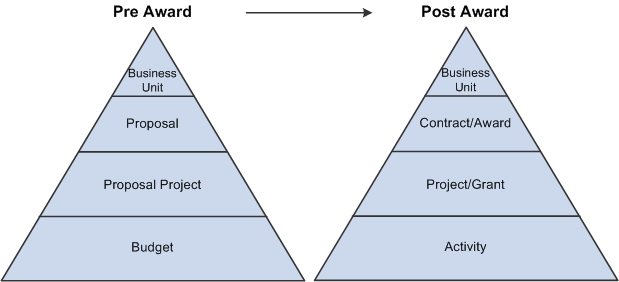
Pre award to post award flow
The following diagram illustrates the hierarchical structure of data in the post award stage, beginning at the highest level with the Grants business unit , then flowing downward to the contract/award, project/grant, activity and finally ending at the resource line – the lowest level of the hierarchy:
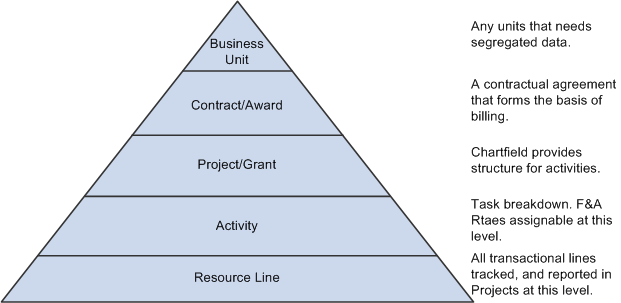
Post award structure
The following diagram illustrates the basic flow of Grants Workflow beginning with the proposal status notification through the proposal approval process. This diagram also includes the milestone due notification process:
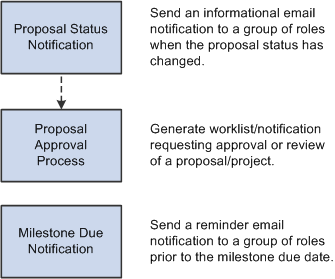
Workflow process diagram
Workflow manages the approval process and provides communication between the different project roles (PI, SPO, administrator, stakeholder, and others) through all aspects of the proposal's life cycle. This is achieved by means of the creation of a workflow process using worklists and email notifications. Select milestones that will be due in the near future and also send out email notifications as needed. The process scheduler can be set up to run this process periodically.
The following diagram illustrates the basic flow of the Protocol Management process. New protocol data is submitted to a committee for review. The committee reviews the protocol and either approves, denies, or returns the protocol. New or draft protocols may also be set to an inactive status. Approved protocols can be copied to new protocols or may be set to an expired status. Returned protocols can be copied and modified or set to an inactive status:
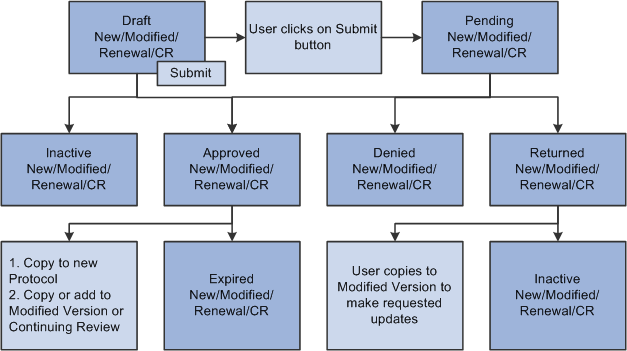
Protocol management process
Protocol Management functionality enables you to:
Capture all required data fields for submission to a review committee for approval.
Copy protocol and version.
Create and submit renewals.
Workflow for status changes, dispositions, meeting agenda, and so on.
Monitor review dates, expirations, renewals, and so on.
Create committee-related components for committee member setup, agenda, documentation of meeting minutes, and so on.
Create My Protocol component.
 PeopleSoft Grants Integrations
PeopleSoft Grants Integrations
This diagram illustrates the integration touch points between PeopleSoft Grants and PeopleSoft Project Costing, Contracts, Human Resource Management, Payables, General Ledger, Purchasing, Receivables, Resource Management, Billing, Time and Labor, and Inventory:
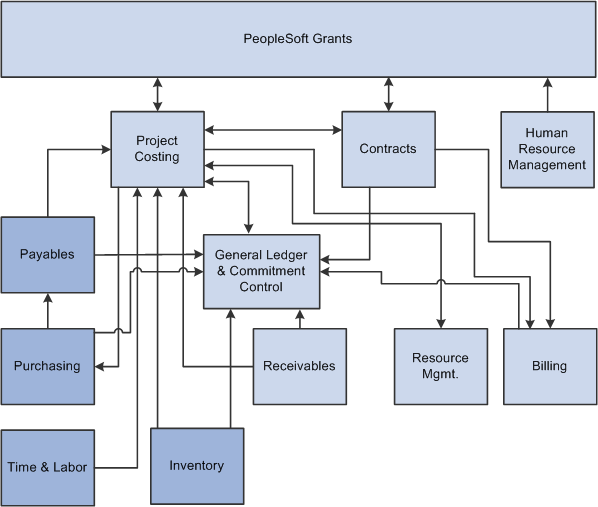
PeopleSoft Grants integration flow with other PeopleSoft applications
We discuss integration considerations in the implementation chapters in this PeopleBook.
Supplemental information about third-party application integrations is located on the My Oracle Support website.
PeopleSoft Contracts and Project Costing
PeopleSoft Grants integrates with PeopleSoft Project Costing and PeopleSoft Contracts to send revenue entries for award transactions to PeopleSoft General Ledger. To book revenue entries to PeopleSoft General Ledger, you need to run a series of processes ending with a process to update the tables in PeopleSoft Project Costing and PeopleSoft Contracts.
PeopleSoft Human Resource Management
To synchronize data with PeopleSoft Human Resources Management (HRMS), PeopleSoft Grants subscribes to application messages. Application messaging is based on the publish-and-subscribe model, which enables PeopleSoft applications to integrate with each other and with third-party applications.
PeopleSoft General Ledger and Commitment Control
PeopleSoft Commitment Control is an optional feature of PeopleSoft General Ledger that enables you to control expenditures actively against predefined, authorized budgets.
PeopleSoft Purchasing
Data flows both ways between PeopleSoft Project Costing and PeopleSoft Purchasing. You can enter requisition lines directly into PeopleSoft Project Costing and then retrieve them through the Purchasing Requisition Loader and process them into requisitions in PeopleSoft Purchasing.
PeopleSoft Receivables
The integration of PeopleSoft Receivables with PeopleSoft Project Costing provides project managers with accounts receivable items and revenue-related adjustments. As a result, project managers have information about the progress of a project in terms of the outstanding revenue.
PeopleSoft Billing
PeopleSoft Grants integrates with PeopleSoft Billing through PeopleSoft Contracts to manage billing for your awards.
PeopleSoft Time and Labor
The system brings labor costs into PeopleSoft Project Costing whenever a user needs estimates for billing. To do this, the system uses tables, enterprise integration points, and other processes that are delivered with PeopleSoft Project Costing and PeopleSoft Time and Labor. To enable data transfer from PeopleSoft Time and Labor to PeopleSoft Project Costing during a payroll period, PeopleSoft Time and Labor uses an estimation process that is linked with Payroll to summarize hours and labor expenses.
PeopleSoft Inventory
After the sourcing routine in PeopleSoft Purchasing identifies an item on a requisition as an inventory item, you can check purchasing availability directly from PeopleSoft Purchasing or create and place a demand on the Inventory Demand Interface table, where PeopleSoft Inventory picks it up. PeopleSoft Inventory then determines whether the demand can be fulfilled.
 PeopleSoft Grants Implementation
PeopleSoft Grants Implementation
Setup Manager enables you to review a list of setup tasks for your organization for the applications that you are implementing. The setup tasks include the components that you must set up, listed in the order in which you must enter data into the component tables, and links to the corresponding PeopleBook documentation.
Because PeopleSoft Grants is a solution that requires the installation of several different applications, you must use Setup Manager separately for each application that you install. PeopleSoft Grants requires that you follow this order when using Setup Manager:
PeopleSoft General Ledger
PeopleSoft Projects
PeopleSoft Billing
PeopleSoft Contracts
PeopleSoft Grants
PeopleSoft Financials also provides component interfaces to help you load data from your existing system into PeopleSoft tables. Use the Excel to Component Interface utility with the component interfaces to populate the tables.
This table lists all of the components that have component interfaces:
|
Component |
Reference |
|
|
Account (GL_ACCOUNT) |
||
|
Alternate Account (ALTACCT) |
||
|
Operating Unit (OPERATING_UNIT) |
||
|
Department (DEPARTMENT) |
||
|
Project ID (PROJECT) |
||
|
Product (PRODUCT) |
||
|
Fund Code (FUND_DEFINITION) |
||
|
Statistics Code (STATISTICS_TBL) |
||
|
Class Field (CLASS_PNL) |
||
|
Budget Reference (BUDREF_PNL) |
||
|
Program Code (PROGRAM_DEFINTION) |
||
|
Scenario (BD_SCENARIO) |
||
|
Chartfield 1 (CHARTFIELD1) |
||
|
Chartfield 2 (CHARTFIELD2) |
||
|
Chartfield 3 (CHARTFIELD3) |
||
|
InterUnit Template (IU_INTER_TMPLT) |
||
|
IntraUnit Template (IU_INTRA_TMPLT) |
||
|
InterUnit Pair Maintenance (IU_INTER_PR_BASIC) |
See Interunit Pairs. |
|
|
Ledgers for a Unit (BUSINESS_UNIT_LED) |
||
|
Value Added Tax Code (TAX_CODE_VAT) |
||
|
VAT Accounts by Business Unit (TAX_BU_CODE_VAT) |
See (Optional) Defining VAT Accounts by General Ledger Business Unit. |
|
|
VAT Entity (VAT_ENTITY_ID) |
||
|
Vat Defaults CI Component (VAT_DEF_CI) |
||
|
Bank Branch Information (BANK_BRANCHPNL) |
See Setting Up Banks. |
|
|
Team Member Types (MEMBER_TYPE_TABLE) |
||
|
Team Member Personal Data (MEMBER_PERSON1) |
||
|
Support Team Members (TEAM_MEMBER_TABLE) |
||
|
Customer Group Table (CUST_GROUP_TBL) |
||
|
Contact Info (CONTACT_INFO) |
See Setting Up Contacts. |
|
|
General Information (CUSTOMER_GENERAL) |
||
|
User Preferences (OPR_DEFAULT) |
||
|
Submit Proposal (GM_PROP_SUBMISSION) |
Other Sources of Information
In the implementation planning phase, take advantage of all PeopleSoft sources of information, including the installation documentation, data models, business process maps, and troubleshooting guidelines. A complete list of these resources is in the preface of PeopleBooks and the Online Library, with information about where to find the most up-to-date version of each.
See Also
PeopleTools PeopleBook: Setup Manager
PeopleTools PeopleBook: PeopleSoft Component Interfaces
PeopleBooks and the Online Library